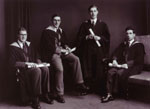

Courtesy Jack Dunitz.
B. Sc. graduation photo with Hugh S. Forrest, Daniel McG. Brown and Drummond Ellis, 1944.
For my doctoral work at Glasgow my first task was that of determining the crystal structurs of acetylenedicarboxylic acid. The reason for this had something to do with the anomalous isotope effect observed some years earlier in crystals of oxalic acid dihydrate, (1) where deuterium substitution led to a slight expansion of the structure in the direction of the main hydrogen bonds instead of the usual contraction. With today's methods the project could be completed in a morning. It took me about three years. In that time I was able to show that the two acid dihydrates had very similar crystal structures and that diacetylenedicarboxylic acid dihydrat, the next member of the series, had a similar but interestingly different structure. Whereas the first two crystals contained centrosymmetric, coplanar molecules, diacetylenedicarboxylic acid molecules were situated on dyad axes and the two carboxylic acid groups were twisted with respect to each other. Nevertheless, the hydrogen bonding network remained very similar in all three structures. (2) We never did get so far as to study the anomalous isotope effect in these crystals. A few years later, a theoretical explanation was given by Nordman and Lipscomb, (3) so it ceased to be anomalous. although I am not convinced that the explanation offered is correct. And fifty years later, I rewrote my first three papers in more modern chemical parlance; the new title was "A Supramolecular Three-Dimensional Hydrogen-Bonded Network with Potential Application in Crystal Engineering Paradigms." (4) Some readers thought it was frivolous but it was meant to be taken seriously.

